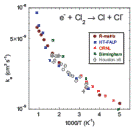Department of Physics and Astronomy: Publications and Other Research
Date of this Version
2007
Abstract
A theory of dissociative electron attachment to molecules condensed at surfaces and embedded within bulk media is developed. The theory of low-energy electron diffraction is used to obtain the width for electron-molecule resonance scattering in the condensed phase from the width for the gas phase. It is then employed for the calculation of dissociative attachment in the framework of the nonlocal complex potential theory. Specific calculations using the effective mass approximation are carried out for electron attachment to CH3Cl and CF3Cl molecules physisorbed on the surface of a Kr film. The role of image states and image-potential resonances is analyzed. The results show an increase by several orders of magnitude in the cross section for physisorbed molecules as compared with gas-phase molecules. This is in general agreement with the measured cross sections. However, the position of the peak in the cross section for CH3Cl is significantly shifted towards higher energies as compared to experiment [K. Nagesha et al., J. Chem. Phys. 114, 4934 (2001)], and the magnitude of the calculated cross section for CF3Cl at the surface is significantly higher than the measured value. Possible reasons for disagreements are analyzed.


Comments
Published in PHYSICAL REVIEW A 76, 012902 (2007). Copyright ©2007 The American Physical Society. Used by permission.